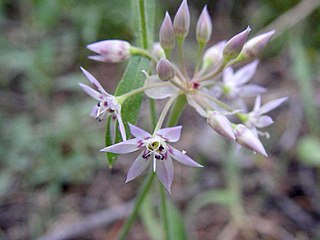
Allium campanulatum is a species of wild onion known by the common name dusky onion or Sierra onion. This is a flowering plant native to the western United States from southeastern Washington and northern Oregon to southern California, and western Nevada. The dusky onion grows in foothills and mountains, especially in dry areas, such as chaparral habitats.

Gilia brecciarum is an annual flowering plant in the phlox family (Polemoniaceae), known by the common name Nevada gilia or break gilia.

Gilia cana is a species of flowering plant in the phlox family known by the common name showy gilia. It is native to California and Nevada where it grows in open areas with gravelly and sandy soils, such as desert and rocky slopes. The Mojave Desert range of some subspecies may extend into Arizona.

Gilia clivorum is a species of flowering plant in the phlox family known by the common names purplespot gilia and many-stemmed gilia. It is native to California and Arizona.
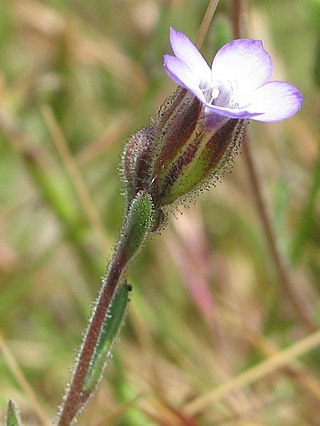
Gilia millefoliata is a species of flowering plant in the phlox family known by the common name manyleaf gilia. It is native to the coastline of Oregon and northern California, where it grows in sand dune habitat.
Gilia minor is a species of flowering plant in the phlox family known by the common name little gilia. It is native to the Mojave Desert and it is also present in the coastal Santa Lucia Mountains of central-southern coastal California.
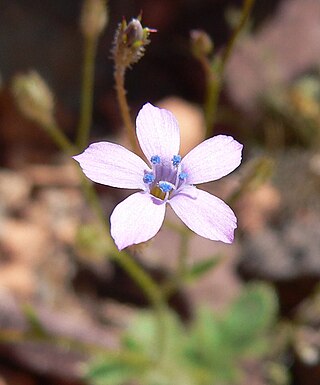
Gilia scopulorum is a species of flowering plant in the phlox family known by the common names rock gilia and Rocky Mountain gilia. It is native to the Mojave and Sonoran Deserts.
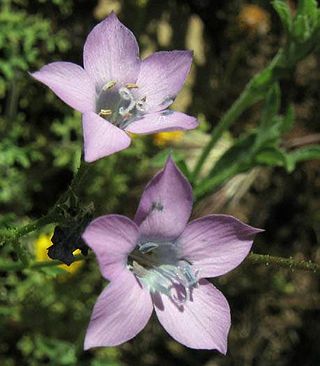
Saltugilia splendens, is a species of flowering plant in the phlox family known by the common names splendid woodland-gilia, Grinnell's gilia and splendid gilia.

Cirsium andrewsii is an uncommon species of thistle known by the common name Franciscan thistle. It is endemic to California, where it is known from the coastline of the San Francisco Bay Area from Marin to San Mateo Counties. There are also reports of isolated populations in the Klamath Mountains and in the Sierra Nevada.
Gilia austrooccidentalis is a species of flowering plant in the phlox family known by the common name southwestern gilia. The scientific name is sometimes spelt Gilia austro-occidentalis. It is endemic to the Central Coast Ranges of California, where it grows in local hill and valley habitat.
Saltugilia caruifolia is a species of flowering plant in the phlox family known by the common names carawayleaf gilia and caraway-leaved woodland-gilia. It is native to the Peninsular Ranges of southern California and northern Baja California, where it grows in local habitat types such as chaparral. This herb produces a thin stem 12 centimeters to about a meter long. The leaves are up to 8 centimeters long at the base of the plant and divided into many finely subdivided lobes. The top of the stem branches into an inflorescence dotted with many glands. It produces flowers with lavender lobes dotted with darker purple near the bases.
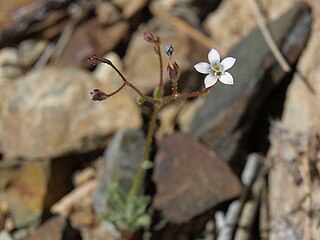
Gilia clokeyi is a species of flowering plant in the phlox family known by the common name Clokey's gilia. It is native to the south-western United States from California to Colorado, where it grows in desert and other habitat.
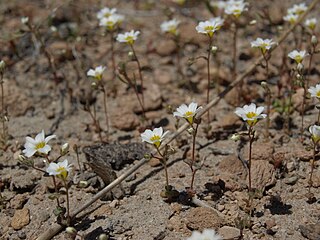
Linanthus inyoensis is a species of flowering plant in the phlox family known by the common name Inyo gilia.

Gilia leptantha is a species of flowering plant in the phlox family known by the common name fineflower gilia.

Aliciella leptomeria is a species of flowering plant in the phlox family known by the common names sand gilia and Great Basin gilia. It is native to the Western United States, where it grows in many types of habitat, such as the sagebrush of the Great Basin and in the Mojave Desert.
Gilia salticola is a species of flowering plant in the phlox family known by the common name salt gilia. It is native to the Sierra Nevada and Modoc Plateau of California and western Nevada, where it grows in volcanic and granitic soils.
Gilia transmontana is a species of flowering plant in the phlox family known by the common name transmontane gilia. It is native to the western United States from California to Utah, where it grows in desert and plateau habitat.
Aliciella triodon is a species of flowering plant in the phlox family known by the common name coyote gilia. It is native to the American desert southwest from California to New Mexico, where it grows in desert habitat such as scrub and woodland. This small herb produces a thin, glandular stem not more than about 13 centimeters tall. The stem is surrounded by a basal rosette of fleshy, sharp-lobed leaves each up to 2 centimeters long. There are sometimes smaller, unlobed leaves on the stem itself. The inflorescence is a solitary flower or loose array of two or three flowers each about 5 to 7 millimeters wide. Each flower has a hair-thin tubular throat opening into a whitish corolla. The corolla lobes each have three distinct teeth.
Gilia yorkii is a rare species of flowering plant in the phlox family known by the common names Boyden Cave gilia and monarch gilia. It is endemic to Fresno County, California, where it is known from only one location in the southern Sierra Nevada. This plant grows in rock cracks in the limestone cliffs and outcrops in the chaparral and woodlands of the canyon.

Saltugilia is a genus of flowering plants in the phlox family, Polemoniaceae. They are known commonly as woodland gilias. There are four species. Two are endemic to California in the United States, and the distributions of the other two extend into Baja California in Mexico.













